
10 of the most parodied artworks of all time
By Annabel Sheen
Published on 30 March 2017
With 'American Gothic' in the UK for the first time, we take a look at some of the other iconic works that have attracted moustaches, Muppets and other mimicry across art history.
How is it that a squirrel reaching for a walnut can summon the Sistine Chapel? That a rubber duck can sit in for one of the most famous girls in art history, and be recognised by its pearl earring? Two hands and a mouth is The Scream. Two people and a pitchfork is American Gothic. Somehow, these works have crossed any boundaries of art and become everyday references, dotted across our screens, novels, and newspapers – copied and celebrated and mocked again and again and again. Sometimes, of course, it’s an artist remaking the work; revisiting past masters is what art history is made of. But there's also the Photoshopper, the political cartoonist, the Simpsons storyboard artist. It's those jokers mischievously swiping the work from its art context and putting it in another one to say something new. Of course, what exactly it is that's being said shifts with each new parody – and what elusive qualities make a work capable of that transcendent, superstar status in the first place? The Cookie Monster’s guess is as good as ours.
American Gothic, Grant Wood, 1930
This portrayal of an Iowan farmer and his daughter (actually posed by Grant Wood's sister and his dentist) is surely among the world's most referenced art works, captivating viewers since Wood painted it in 1930. Ever since then, they've wrestled with the question – was Grant Wood satirising these serious, plain-living country folk or celebrating them? What is he saying about life in rural, post-war depression-era America? It’s not something that Wood ever answered outright. That ambiguity and those enigmatic stares have opened the (Gothic-style) door to a century’s worth of debate and a whole lot of parodies, with everyone from Kim Kardashian to Chewbacca to Amy Schumer to Donald Trump taking their place in this politically charged icon of a nation.
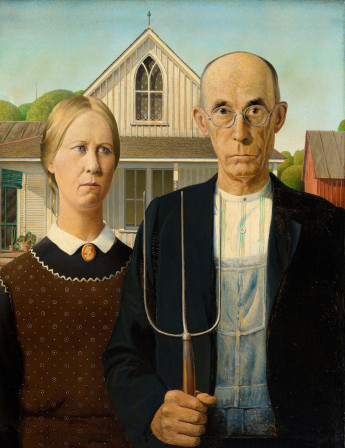
American Gothic, 1930



Mona Lisa, Leonardo da Vinci, 1503
By the time Duchamp doodled a moustache onto a postcard of the Mona Lisa in 1919, Leonardo’s portrait had already reached superstar status, with a vast number of prints in circulation. Even in the 16th century, artists were copying and admiring the softness of this enigmatic half-length portrait, her ambiguous expression and her otherworldly backdrop. The painting’s celebrity was also boosted by a high-profile theft from the Louvre in 1911, when Paris police circulated 6,500 images of the painting and in which Picasso was one of the first suspects. It turned out that she was snatched overnight by the Louvre’s painter and decorator, Vincenzo Perruggia, and was returned to the Louvre two years later. Since then, everyone from Kristen Stewart to Beyoncé and Nicole Scherzinger have sat in for La Gioconda, as she is known (the sitter is thought to be Lisa Gherardini, the wife of a Florentine cloth merchant named Francesco del Giocondo).
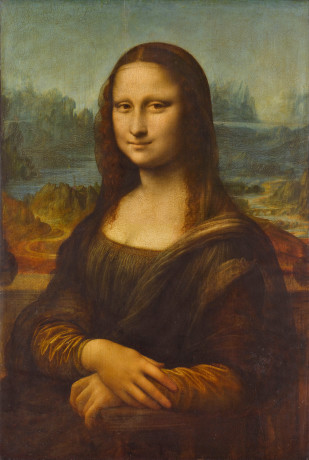
La Joconde, portrait de Mona Lisa, c.1505


From 'Miss Piggy's Treasury of Art Masterpieces from the Kermitage Collection', by Michael K. Frith

will.i.am, 'Mona Lisa Smile' ft. Nicole Scherzinger
The Great Wave off Kanagawa, Katsushika Hokusai, 1829–1832
One of the most famous graphic images in the world, Hokusai’s The Great Wave was issued widely as a woodblock print and quickly caught the attention of collectors in Europe, later influencing artists including Whistler, Monet and Van Gogh. The print is one of Hokusai’s 36 views of Mount Fuji, Japan’s tallest mountain, but in this image the mountain is remote and comically small, eclipsed by the colossal wave. Scarily dwarfing the rowboats, the arching wave feels almost anthropomorphic – and works surprisingly well reimagined as the Cookie Monster. Many other helpless characters have also been plunged into its tumultuous waters over the years, including the pokémon Gyarados and the minimal techno producer Richie Hawtin.
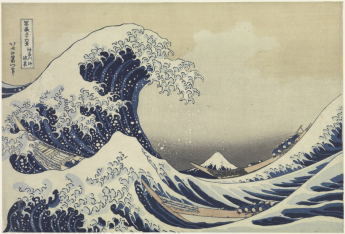
Kanagawa oki Nami ura (The Great Wave at Kanagawa), c.1830-32

The Great Wave Motherboard,

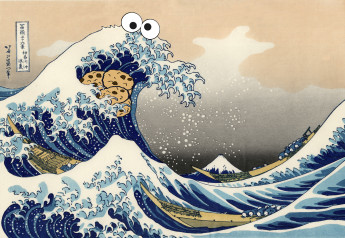
Sea is for Cookie, 2013
The Birth of Venus, Sandro Botticelli, 1484–1486
A shocking display of female nudity in the 15th century, Botticelli’s Birth of Venus is often regarded as the foot in the door to modernity – or at least to modern depictions of feminine beauty. The life-size painting depicts the point in Ovid’s Metamorphoses when Venus emerges from the sea as a fully formed, fully naked adult, drifting to her place on land as the goddess of love and beauty. Too risqué for public viewing, this coy full-frontal spent its first few decades behind closed doors, and only really claimed its rightful place in art history four centuries later, when the Pre-Raphaelite brotherhood instigated a major rethink of Botticelli’s works. Since then, it has informed ideas of the female nude – and has inspired imitation from some other lovers of the limelight (ahem, Miss Piggy).
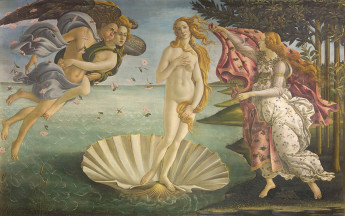
The Birth of Venus, 1482-85
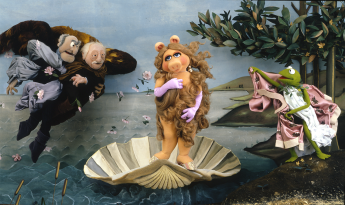
From 'Miss Piggy's Treasury of Art Masterpieces from the Kermitage Collection', by Michael K. Frith
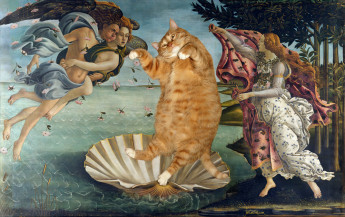
The Purr of Venus,
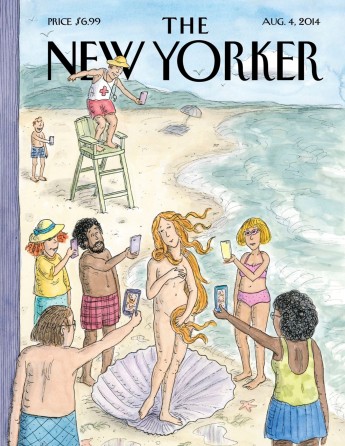
The Last Supper, Leonardo da Vinci, 1495–1498
Painted in the late 15th century, Leonardo’s style of representation for this eminent biblical scene – Christ’s breaking of bread with his disciples – was innovative in its time. Unlike the static images that preceded it, this Last Supper is alive with the spontaneity of conversation and gesture. And yet those gestures are so carefully and creatively composed that parodies need only reference a few of them to conjure the masterpiece, which is constructed with almost mathematical precision and Leonardo’s acute interest in the movement of bodies. These days, everyone from Kendrick Lamar to Gordon Ramsay and a gang of celebrity chefs to grime artist Stormzy have had last suppers – and of course, it's a go-to fancy dress costume for any art-loving group.
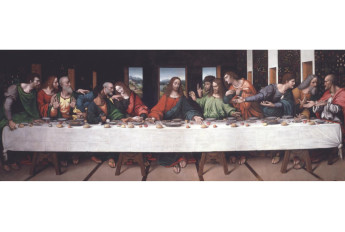
The Last Supper, c.1520

Lesbian Last Supper. L-R: Jane Lynch, Sandra Bernhard, Rachel Maddow, Linda Perry, Shane McCutcheon as Judas, Portria de Rossi, Ellen Degeneres, Heather Matarazzo, Wanda Sykes, KD Lang, Lily Tomlin, Melissa Etheridge, and Rosie O'Donnell, 2012

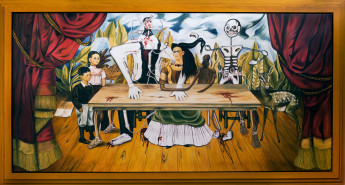
The Wounded Table (replica), original painted 1939-40
Girl with a Pearl Earring, Johannes Vermeer, c.1665
In 1881, 200 years after it was made, this work sold at auction for the bargain price of two guilders and 30 cents (the equivalent of around €24). And yet today it is the poster image for The Hague’s Mauritshuis Museu and famous worldwide – sometimes referred to as the Dutch Mona Lisa. Surprisingly little is known about the painting, but it’s thought that Girl with a Pearl Earring is not a portrait but a "tronie" – a representation of a type of person; here, an exotic character. That the girl is not thought to be based on a real person hasn’t deterred the storytellers, of course; Tracy Chevalier’s 1999 best-selling novel is one of the most famous interpretations of the Girl’s story, and was subsequently made into a film starring Scarlett Johansson and Colin Firth. As well as cavorting with Colin, Vermeer’s exotic girl has modelled for Banksy, appearing in Girl with a Pierced Eardrum. She can also be found in the Mauritshuis’s own gift shop, in the form of this lovely rubber ducky with pearl earring.
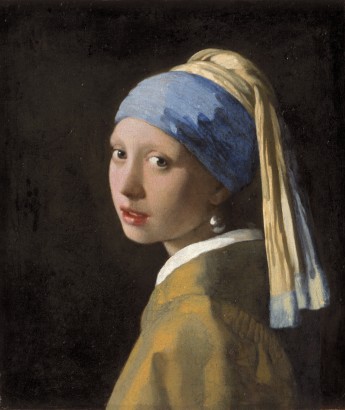
Meisje met de parel (Girl with a Pearl Earring), c.1665
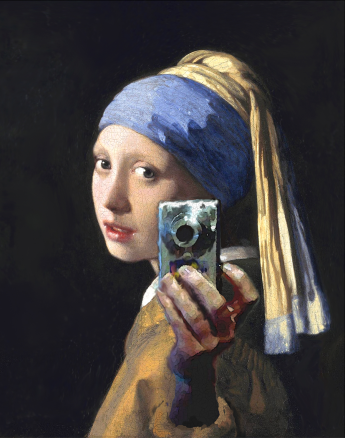
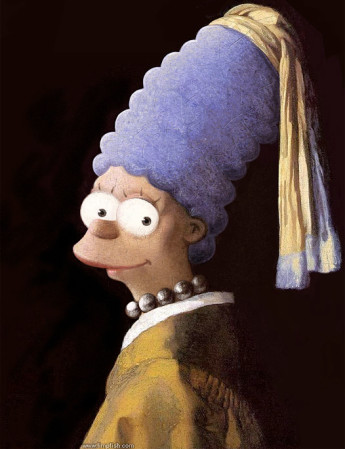

The Scream, Edvard Munch, 1893
Perhaps the second most famous painting in the world, Munch’s emotive wail has captured our collective imagination over the past 100 years – that ambiguous, androgynous central figure seeming to convey some sort of universal human experience. In fact, it's often thought to be a self-portrait; the Norwegian artist described his inspiration in a diary entry in 1892: “suddenly the sky turned a bloody red. I stopped, leaned against the railing, tired to death – as the flaming skies hung like blood and sword over the blue-black fjord and the city… I stood there trembling with anxiety – and I felt a vast infinite scream through nature”. The resulting scream – or screams; Munch made four versions in his lifetime – has echoed down the decades, becoming the go-to representation of horror across the arts and the media. You’ll find references in the work of Andy Warhol, the novels of Philip K. Dick – and of course, in 1996’s slasher film Scream, as the “Ghostface” mask. Slightly less fearsome is Macauley Culkin on the Home Alone poster – and indeed, the scream emoji.
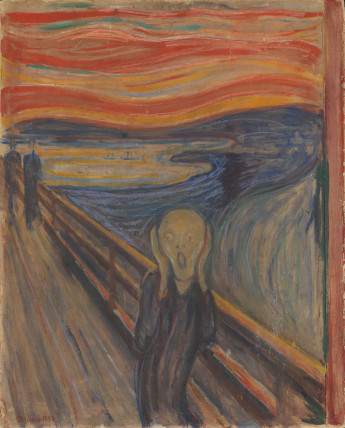
The Scream, 1895
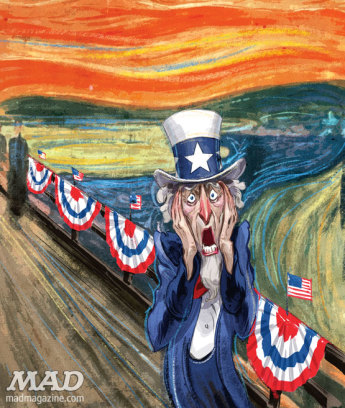


The Scream (after Edvard Munch),
The Thinker, Auguste Rodin, 1880–1904
Rodin conceived of The Thinker as a smaller figure to sit atop his haunting 1880 sculpture, The Gates of Hell, depicting a scene from Dante's Inferno. The thinking figure initially represented author Dante, shown nude, head in hands, hopelessly contemplating the despair of the lost souls surrounding him. Rodin later created a separate statue, first called Poet and later known as The Thinker, which no longer represented Dante but embodied all mankind. As well as having been re-cast numerous times around the world, The Thinker can be found across pop culture in countless sizes and guises. Among those contemplating their existence are Mickey Mouse, Peter Griffin and a rather pensive elephant.

Le Penseur (The Thinker), 1903
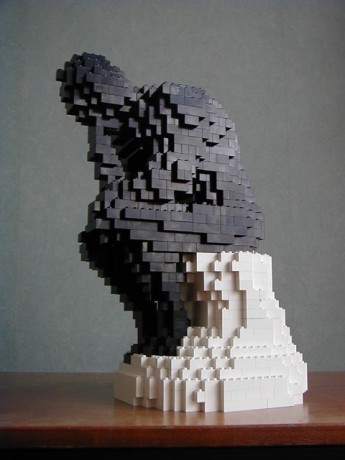
Rodin's Thinker in LEGO®,
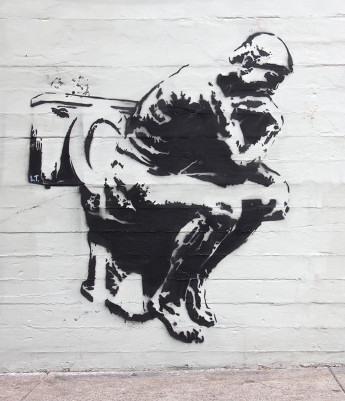
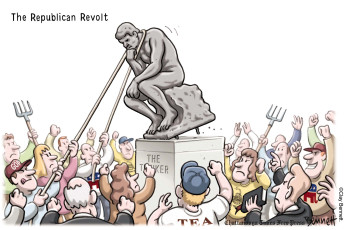
Starry Night, Vincent van Gogh, 1889
The whirling panorama of Van Gogh’s Starry Night was painted as much from imagination as from the view from the artist’s window in his asylum in Saint-Rémy. In 1888, the artist wrote in a letter that “the night sky is much more alive and richly coloured than the day,” a feeling expressed in his characteristic heavy brushstrokes, loose colour palette and abandon of realistic form. He would paint the view 21 times during his stay – but it’s this one that has inspired generations of dreamers and mimics, including Woody Allen, with everyone from Batman to Pac Man making an appearance under that starry sky.
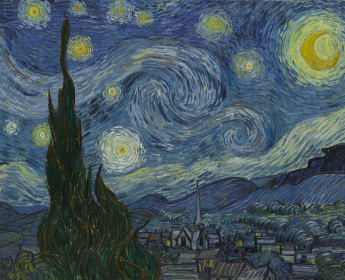
Starry Night, 1889

Starry Night at Hogwarts,
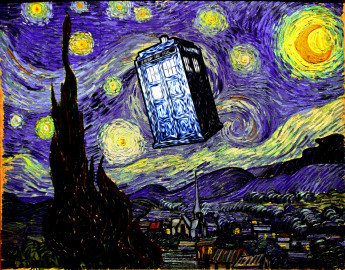
The Tardis in the Starry Night,
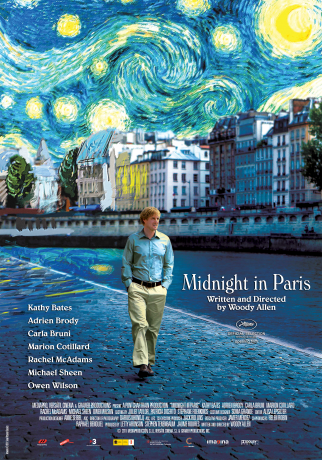
Nighthawks, Edward Hopper, 1942
Within months of being painted, Hopper’s Nighthawks was a hit: bought by the Art Institute of Chicago, where it still hangs, it became one of the artist’s most renowned works. Hopper once suggested that the all-night diner visited by these “nighthawks” – the three customers perched silently at the bar – was inspired by a restaurant in New York’s Greenwich Avenue, but it’s thought to be largely imaginary, a generalisation of the average American diner in 1942. Hopper acknowledged the sense of isolation so many find in his paintings – but denied that he’d put it there deliberately: “unconsciously, probably, I was painting the loneliness of a large city”. Naturally, the illustrative scene has been reinvented as everybody’s late night local, whether a Starbucks, McDonalds, or a bar on an unsinkable ship, frequented by the Muppets, the Cat in the Hat, Batman at the end of a busy night in Gotham, or erm, hawks.

Nighthawks, 1942
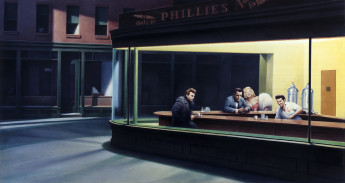
Boulevard of Broken Dreams (Nighthawks), 1984

Wi-Fi Diner (originally produced for Wired Magazine), 2004
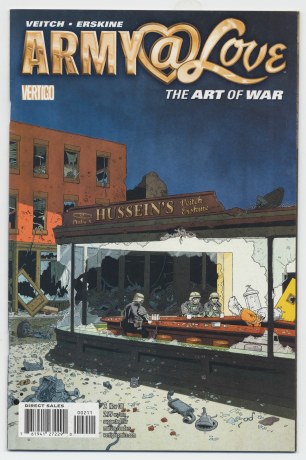
See also...
Salvador Dali's The Persistence of Memory
...reimagined with soft, freshly baked cookies or sleepy, overweight cats or sizzling eggs, sunny side up.
Andy Warhol's silkscreens of Marilyn Monroe
...with Boris Johnson, Michael Jackson, and Frankenstein standing in for the movie star.
Michelangelo's statue of David
...with a little extra weight, a slightly more lean physique, and some breasts. Not to mention a reptilian reincarnation by the world's second most famous Michelangelo.
Michelangelo's Creation of Adam
...with a flying spaghetti monster or a squirrel in the place of God, or the miraculous creation of Neil Patrick Harris, as watched over by RuPaul.
America after the Fall: Painting in the 1930s, The Sackler Wing, Royal Academy of Arts, London, until 4 June 2017.
Related articles

Art telly to watch this Christmas
11 December 2024

Moving a masterpiece
7 November 2024
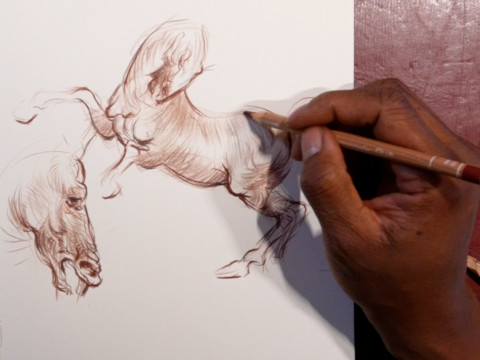
Video: learning from Leonardo at Windsor Castle
4 November 2024